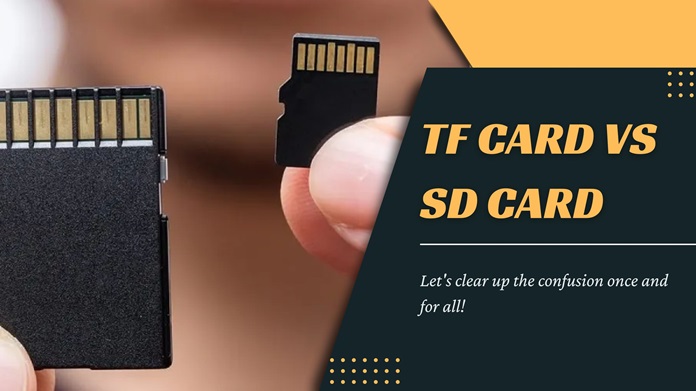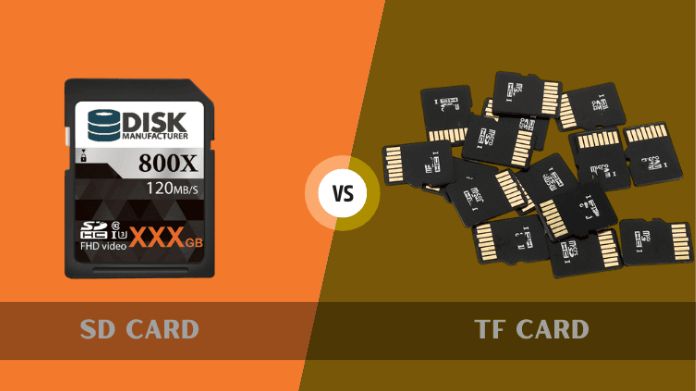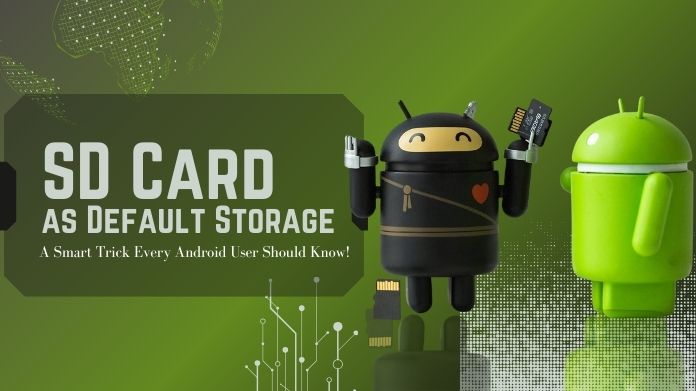TF cards and SD cards are widely utilized in the realm of digital storage, yet customers are sometimes confused by their distinctions.
Tech enthusiasts and professionals who need to choose the correct memory card between TF card vs SD card for their devices must be aware of these variances.
This post will explain each card’s features and highlight how they vary in terms of compatibility, storage capacity, physical attributes, and other areas.
You’ll know in the end which card best fits your requirements.

What is a TF Card?
A TF (TransFlash) card was introduced by SanDisk in 2004 as the world’s smallest memory card. TF cards were originally intended to provide storage options for small devices, such as action cameras, drones, and cell phones.
Over time, TF cards were rebranded as microSD cards, a name most people are familiar with today.
They continue to provide portable storage in a small form factor despite the name change. Today, you’ll find TF cards in devices that require small yet versatile memory options, such as smartphones, tablets, GPS devices, and certain cameras.
What is an SD Card?
An SD (Secure Digital) card is a more commonly used type of flash memory storage. Since its introduction in 1999, the SD card has been the preferred storage solution for many electronic gadgets.
SD cards exist in a variety of sizes, including normal SD, miniSD, and microSD (a rebranded TF card).
Each size caters to different device needs, from digital cameras and laptops to gaming consoles.
The versatility and reliability of SD cards have made them a staple in consumer electronics, offering options for various capacities and speeds.
What is a TF Card Vs SD Card? Quick Comparison
While TF and SD cards serve the same fundamental purpose—storing data—they differ in several key aspects:
| Features | TF Cards | SD Card |
| Size | 15mm x 11mm x 1mm | 32mm x 24mm x 2.1mm (Standard) |
| Write-Protection Switch | No | Yes |
| Common Device | Smartphones, drones, tablets | Cameras, laptops, gaming consoles |
| Compatibility | TF card slots, adapters needed for SD slots | Directly compatible with SD slots |
| Typical Capacity Range | 2GB to 1TB | 2GB to 1TB |
Detailed differences are given below:

TF Card vs SD Card: Physical Differences
Physically, the most noticeable difference between TF and standard SD cards is their size. TF cards are smaller, measuring 15mm x 11mm x 1mm, while a standard SD card is significantly larger at 32mm x 24mm x 2.1mm.
This compactness makes TF cards ideal for small devices where space is a premium. Standard SD cards have a write-protection switch, a tiny physical slider that can stop unintentional data overwrites.
This is another obvious distinction. Since TF cards lack this functionality, accidental data tampering may be more likely to occur.
TF Card vs SD Card: Storage Capacity and Speed
TF and SD cards are available in a variety of storage capacities ranging from 2GB to 1TB. The difference is how quickly data can be read from or written to the card after speed classes, not their capacity.
Speed classes are denoted by ratings such as Class 4, Class 10, UHS-I, or UHS-II. Higher numbers mean faster read and write speeds — important for when you’re recording high-resolution video or running applications from the card itself.
While both card types can support high speeds, SD cards, particularly the larger ones, are often preferred for tasks like professional photography and 4K video recording due to their more robust speed options.
TF Card vs SD Card: Compatibility and Usage
Smartphones, action cameras, and drones are the most common applications for TF cards. They may also be utilized in conventional SD card slots with the use of an adaptor.
Conversely, normal SD cards are more frequently utilized in gadgets where the card’s physical size is not a limitation, such as digital cameras, computers, and game consoles.
Because SD cards are easy to use and have direct interoperability, they are often preferred over devices that have specific memory slots.
TF Card vs SD Card: Price and Availability
However, both TF cards and SD cards have different prices according to their storage size as well as speed class.
TF cards are usually slightly cheaper, being smaller and carrying fewer physical features (such as a write-protection switch).
SD cards provided more storage but also were more costly, particular if one wanted faster speed ratings and larger storage sizes.
Both types have a wide range of availability and various brands reserving theirs. Market trends show a growing preference for higher capacity and faster cards, driving down the cost of lower-capacity options.
How to Format a TF Card or SD Card?
Formatting a memory card ensures optimal performance and longevity. Here’s how you can format both TF and SD cards:
- Using a Computer: Place the card into the computer, if needed using an adapter. Go to ‘File Explorer,’ right-click on the card, and select ‘Format.’ Choose the file system (FAT32 for cards up to 32GB, exFAT for larger cards), then click ‘Start.’
- Using a Smartphone or Camera: After inserting the card into the device, choose “Format” or “Erase Card” from the settings or storage menu.
- Using SD card Formatter: After downloading the SD card formatter, simply insert the memory card > Launch the SD card Formatter> Select the SD card > Choose the suitable format (Quick format, Overwrite format, Format size adjustment) > Start Formatting.
Prior to formatting, make a backup of any crucial information because it will remove everything off the card.
Choosing Between a TF Card and an SD Card
When deciding between a TF card vs SD card, examine the device you intend to use it with and your individual requirements.
For photography or videography, where speed and reliability are crucial, an SD card may be the better choice.
If you need a small storage solution for a smartphone, drone, or action camera, a TF card is probably a better option. Always check device compatibility, required speed, and budget before making a decision.
Final Words
Similar in function as TF cards, SD cards, however, have some key differences such as size, speed, compatibility and use.
Ultimately, the decision depends on the specific aspects and context, for instance, an equipment in use and information to be stored.
TF cards are ideal for tiny handheld devices, whereas SD cards provide more flexibility and speed for the bigger form factor devices.
In this manner, you will be able to note the differences and make a decision that meets your storage need.



